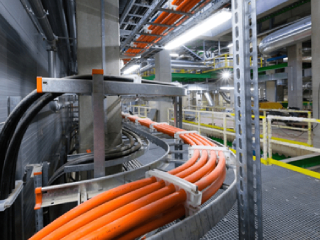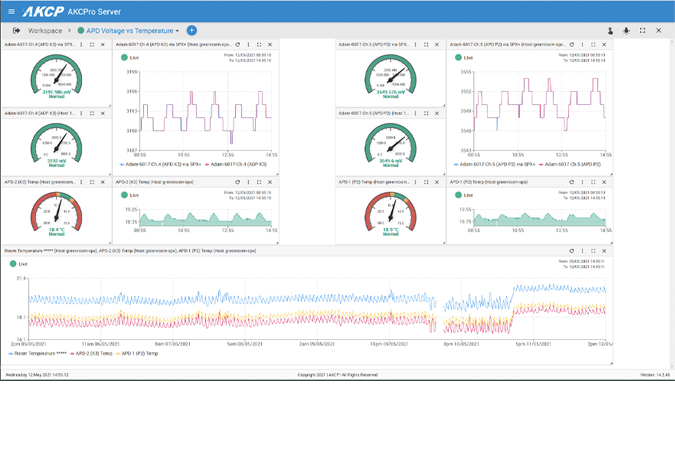Safety First Mindset
Safety is a concern that should not be put aside or is merely for compliance. Safety in data centers should be a continuous commitment, transparent, and an integral part of day-to-day operations. A data center must prioritize creating a culture where safety is always at the top of the list.
Due to the high power availability in a data center, the safety leader should have an electrical engineering background. This leader should be able to:
- Establish And Implement Safety and Health Policies
- Develop Training Programs
- Investigate and Acquire High-Quality Safety Equipment
- Conduct Periodic Audits And Inspections
- Continuously Monitor And Actively Comply With Safety Standards
Understand The Relevant Standards
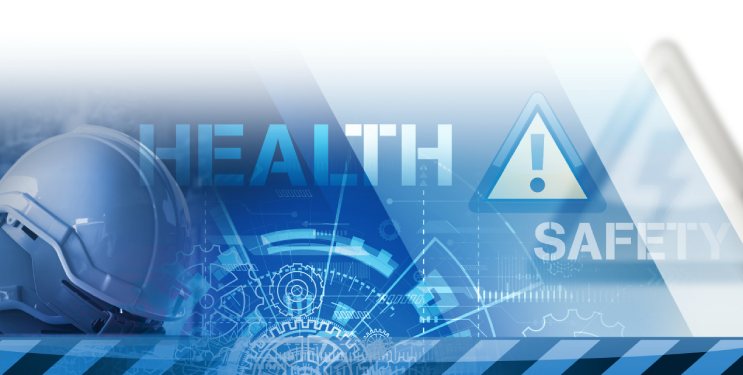
Photo Credit: datacenterfrontier.com
Since a data center is mostly run by IT Professionals and not electric engineers, the IT administrators may not always be familiar with the dangers posed by certain high-power electrical systems in the data center.
As a result, data center operators must be aware of and follow the important safety standards for facilities allowing workers to work on electrical equipment. These prerequisites are as follows:
− NFPA 70 edition 2002: National Electrical Code.
− FPA 70E edition 2000: Standard for Electrical Safety Requirements for Employee Workplaces.
− IEEE Standard edition 1584-2002: Guide for Performing Arc Flash Hazard Calculations.
− OSHA 29 Code of Federal Regulations (CFR) Part 1910 Subpart S.
In addition, OSHA requires that facilities strictly adhere to a six-point plan to minimize and protect workers from arc flash incidents:
− Provide and be able to demonstrate a safety program with defined responsibilities.
− Calculate the degree of arc flash hazard.
− Use correct personal protective equipment (PPE) for workers.
− Train workers on the hazards of arc flash.
− Use appropriate tools for safe working.
− Provide warning labels on equipment.
Two portions of the OSHA standard, commonly referred to as lockout or Tagout procedures, should be of special relevance to data center operators. OSHA 29 Code of Federal Regulations Part 1910.147, The Control of Hazardous Energy (Tagout and Lockout), establishes explicit principles and procedures for disabling machinery or equipment to prevent the release of hazardous energy while employees perform service and maintenance activities. Controlling hazardous energies, such as electrical, mechanical, hydraulic, pneumatic, chemical, thermal, and other energy sources are outlined in the standard.
In addition, OSHA’s Title 29 Code of Federal Regulations (CFR) Part 1910.147 lays out the rules for employees who work with electric circuits and equipment. Workers must follow safe work practices, such as lockout and tag-out procedures, according to this provision. These restrictions apply when personnel is working on, near, or with conductors or systems that use electric energy and are exposed to electrical risks.
These criteria must be understood and followed by data center operators. Compliance with these rules, according to OSHA, prevents 120 deaths and 50,000 injuries each year.
Observe Safe Working Practices
Safe working practices should begin even before the data center is built. An arc flash hazard study for the facility’s electrical distribution system is a key aspect of complying with electrical safety requirements. This is engineering research usually composed of:
- Short Circuit Analysis
- Protective DeviceTime-Current Coordination Study
- Actual Arc Flash Danger Analysis
This study projects estimated potential energy that would be released in the event of an arcing fault inside the equipment at each location in the system. This analysis can be used to estimate the level of hazard and the proper personal protective equipment (PPE) that personnel should wear.
Have The Right Personal Protective Equipment (PPE) For The Job
The last line of defense against arc flash injury or death is personal protective equipment (PPE). This might include the following:
- Flame-Resistant (FR) Clothes.
- Voltage-Rated Loves.
- Hard Hats With Full Face Shields.
- Full-Coverage Flash Suits.
- Insulated Blankets.
When a worker exceeds the flash protection barrier, PPE is required. Although the type and amount of PPE required varies depending on the hazard.
The proper level of PPE is determined by the risk that is expected. A worker who wears insufficient PPE is at risk of serious injury or death. Too much PPE can be cumbersome and hinder vision and movement, lengthening work time and increasing the risk of an accident. In all circumstances, NFPA 70E Table 130.7(C)(1)(a) describes the proper PPE to employ.
Use Proper Warning Labels
All equipment must be labeled with an appropriate warning sign. It is the data center operators, not the manufacturer, supplier, or installer, responsibility to label the equipment. Arc flash warning labels should provide additional information above what is necessary by law for maximum protection. “Danger” is written on a sticker. While “High Voltage” complies with regulations, it is too broad and is likely to be overlooked. Workers will have the information they need to make informed decisions about safety procedures if more information is provided on the sticker. Many companies opt to label equipment with the flash danger values found during the analysis. Current standards do not require these values to be labeled on equipment, however, it is a good practice for workers’ safety.
Safe Working Area Compliance
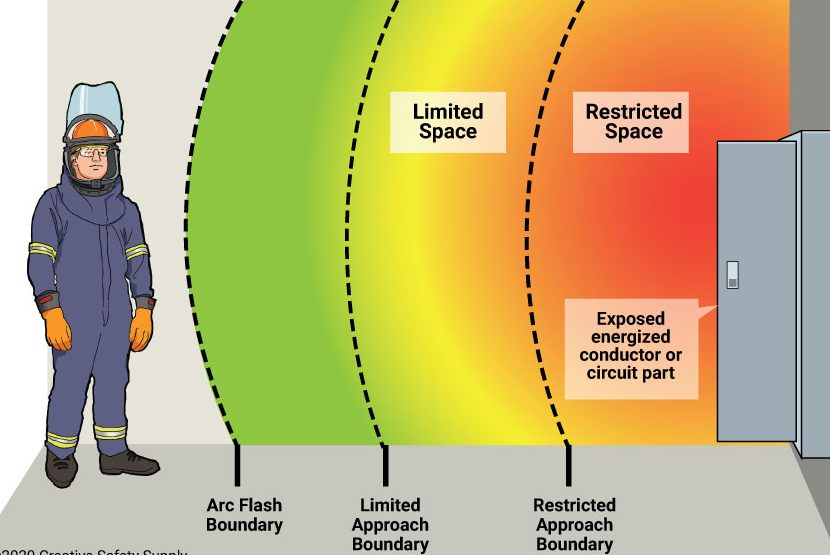
Photo Credit: cdn11.bigcommerce.com
When an individual works on or near exposed energized components in a data center, arc flash boundaries are necessary around switchboards, panelboards, industrial control panels, motor control centers, and similar equipment. Examining, adjusting, repairing, maintaining, or troubleshooting equipment are all activities that are subject to arc flash boundaries. Specific boundaries include:
- Boundary For Flash Protection
If an electric arc flash occurred, a worker could incur a second-degree burn if they approached too close to exposed live parts. Workers entering the flash protection zone must wear the proper personal protective equipment (PPE).
- The Approach Boundary Is Restricted.
A distance from an exposed live part within which a shock hazard occurs that has an approach restriction. A person who crosses this line and enters the restricted area must be qualified to do the job or task.
- Approach Is Restricted At This Point.
An approach limit at a distance from an exposed live part within which persons working close to the live part face an elevated risk of shock from an electrical arc mixed with unintended movement. Crossing this approach boundary and entering the restricted space requires a documented work plan that has been approved by authorized management, as well as the proper PPE for the job being done and the voltage and energy levels involved.
- Approaching The Edge Of The Forbidden Zone Is Prohibited.
A distance from an exposed living part within which work is treated as though it were made touch with the live part. To work on energized conductors or live parts, anybody entering the restricted area must have the necessary training. In this location, tools must be rated for direct contact at the voltage and energy levels involved.
The Danger Of Electrocution
Electrical shock or electrocution is the most evident and well-understood threat to data center workers. To get shocked, the worker must touch an energized surface, such as a terminal or bus bar, and become a part of the electrical route. The current travels through the body, injuring or killing people.
The keys to avoiding electrocution are simple to understand. Employees must wear the proper safety gear and unplug or otherwise de-energize live equipment before working on or near it, according to OSHA requirements.
Today’s data centers are increasingly using low- and medium-voltage touch-safe panelboards, breakers, switches, and other devices that are doubly insulated and help avoid worker exposure to live parts to further reduce the risk of electrical shock. This eliminates the risk of electrocution and eliminates the need to de-energize vast areas of the data center in order to maintain them.
Consider Possible Arc Flash Accidents
Arc flashes are possibly the most dangerous threat to data center workers. As data centers are operating with multi-megawatt electricity, they are easily vulnerable to arc-flash incidents. Undoubtedly, can result in significant damage, fire, injury, or death. The United States averages 5 to 10 a day for arc flashes. With 20% of them occurring in motor control centers and switchgear and another 18% in bespoke control panels.
The risks of electric arc have just been properly known in the last 20 to 30 years. Arc flashes were first mentioned in a paper published in the IEEE Transactions on Industrial Applications in 1985.
National Fire Protection Association (NFPA) defined this phenomenon as a dangerous condition connected with the release of energy induced by an electric arc. With a hazard to workers being equivalent to the available short circuit current in the circuit and the arc duration.
Two or more separated, energized conducting surfaces attract electricity to travel between them, forming an arc. When an arc is formed, the surrounding atmosphere is rapidly heated to temperatures of up to 20,000°K, resulting in the formation of plasma. Conductors evaporate. Metal transitions from solid to a gaseous state. This expansion also generates a high-pressure wave that can reach 500 pounds per square inch, strong enough to rip 3/8″ bolts and blast entire substations apart. It can even crush a person’s chest to kill them without burning them.
Electric arc burns account for a large percentage of electrical-related injuries. Arcs can produce temperatures as high as 35,000°F, approximately four times that of the sun’s surface. At a distance of up to five feet, the outcome can be fatal burns, and at a distance of up to ten feet, the result can be serious burns.
The arc flash creates a 5,000-foot-per-second fireball that contains metal droplets and copper fumes that behave as shrapnel, injuring not only the worker but also anyone close. People can be temporarily or permanently blinded or have their eyes damaged by the strong light created by the arc. Sound levels can reach startling 160 decibels vs 115 concert decibels and cause permanent hearing loss.
Arc flashes can ruin equipment, creating significant downtime and necessitating costly replacement and repair, in addition to the possibility of injury and death. They can also ignite flammable things in the vicinity, resulting in secondary fires that can destroy entire buildings.
Protection Against Arc Flash Is A Must
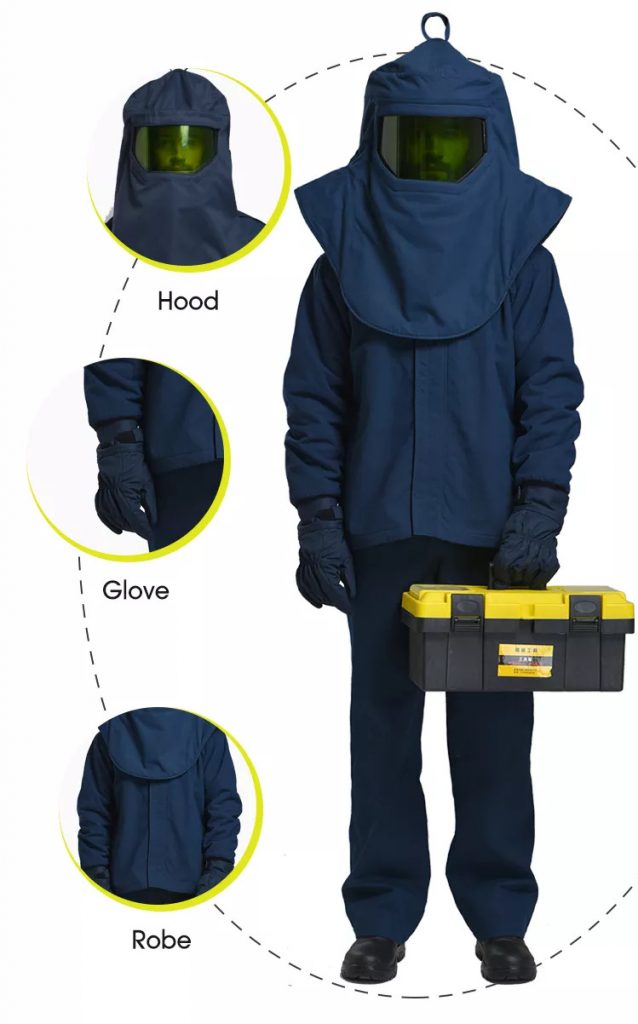
Photo Credit: sc01.alicdn.com
The massive amounts of electricity available at a data center’s switchgear and motor control centers make arc flashes a distinct possibility. Today’s data centers are increasingly adopting technologies that protect against arc flash incidents in one of two ways: by confining the event’s energy or by swiftly cutting off the arc’s source.
Products that provide passive arc flash protection seek to confine the arc flash to the area where it occurs. This reduces possible damage to equipment and humans. Arc-resistant switchgear is being installed in many data centers to lessen the risk of employee harm and equipment damage. When an arc fault occurs, this equipment directs the expanding hot gases away from employees at the front, back, and sides of the switchgear through a system of vents and flaps. To survive the transient pressure spike until relief vents and flaps activate. Then thee switchgear doors, walls, and panels are reinforced and sealed. Damage is contained in the compartment where the fault originated, rather than spreading to adjacent compartments, thanks to this design.
Products that provide active protection against arc flashes aim to minimize or eliminate the energy released by the arc flash itself. These technologies are designed to swiftly detect the massive and practically instantaneous rise in light intensity that accompanies an arc flash fault—up to several thousand times typical ambient lighting levels—and then act to reduce the arcing period.
Arc flash detection solutions can send out a trip signal in as low as 2.5 milliseconds after the arcing fault has started. A low-voltage detection and relay system, for example, uses a fiber optic sensor to detect the flash, quickly analyses the signal, and sends a trip or disconnect signal to terminate the arc.
In the event of an arcing fault, another form of the product combines numerous components, such as detection and release electronics and related primary switching elements, to launch a parallel three-phase short-circuit to earth. The primary switching element’s exceptionally fast switching time, often less than 1.5 milliseconds, along with the rapid and reliable detection of overcurrent and light, ensures that an arc fault is extinguished practically instantly. Switchgear may accomplish the highest level of protection for both people and equipment with this method.
Remote monitoring items are being used to guard against arc flash. Many organizations use products that monitor and diagnose electrical equipment remotely. This decreases the risk of an arc flash occurrence by limiting direct employee exposure to equipment.
Small, equipment-specific monitoring items, such as remote temperature sensors for power buses, to centralized systems, such as AKCPro Server: Centralized Monitoring Software, which monitors almost all data center processes, are examples of these monitoring solutions. Interlocks or lockouts prevent personnel from operating a potentially dangerous device or provide alternate control techniques to assure safe operation while preserving uptime in the latter.
Don’t Get Comfortable
There are no regulations, standards, or safety czars that can substitute common sense when it comes to safeguarding the safety and health of data center employees. There’s always an inherent risk when human people work with electrical equipment. This is the reason for having the standards, and why they must be strictly adhered to. Don’t get too comfortable.
A false sense of security could be the biggest threat for human employees in a data center. This could lead to carelessness and should always be avoided. Always keep in mind that every task involving electricity is risky. Always be vigilant and practice double-checking. And never deviate from the rules!
AKCP Monitoring Solutions
For data center monitoring, including uninterruptible power supply monitoring, AKCPro Server is a must-have remote monitoring software solution.
We remote battery, generator, and UPS monitoring and management in real-time. AKCPro Server acts as the eyes and ears of your physical spaces, sending SMS and app alerts as soon as something happens. If any of the following occurs, certain personnel are notified:
- Extreme Temperature
- Water Leak
- Humidity Fluctuations
- VOC Gas Presence
- Unauthorized Entry
- Power or Equipment Failure
- Loss of Connectivity
- Airflow Disruption
An independent cellular gateway powers up to 30 individual environmental sensors. It records the trend and notifies designated employees when equipment status or environmental threats are detected. To enhance operating efficiency and safety and health in the data center, use proprietary predictive analytics to analyze circumstances and keep track of routines.
The following data center and server room equipment are monitored by our data center monitoring solution: UPS, generator, switchgear, communications gear, other mission-critical backup battery systems, and TCP/IP devices.
- Scalability is required in all data centers, from data closets to data centers.
- Ensure that employee productivity is not harmed as a result of switch failures.
- Preventing disruptions to IT infrastructure, unplanned outages, and downtime.
- Prevents disaster thru E-mail, SNMP Trap, SMS, and phone-call warnings are all accessible. When your sensors are in catastrophic condition, you’ll know it.
You can ensure staff safety and health in the data center, quickly identify occurrences that could cause service interruptions, and protect your investments by using AKCPro Server to boost data center safety in terms of data center battery monitoring and UPS monitoring.
Reference Links:
https://www.datacenterdynamics.com/en/opinions/three-ways-to-ensure-your-data-center-employees-are-safe-at-work/
https://www.techtarget.com/searchdatacenter/tip/Best-practices-for-data-center-risk-assessment
https://ohsonline.com/Articles/2016/04/01/Data-Center-EHS-101.aspx
https://www.safetysure.com.au/safety-advice/managing-work-health-safety-in-a-data-centre/


